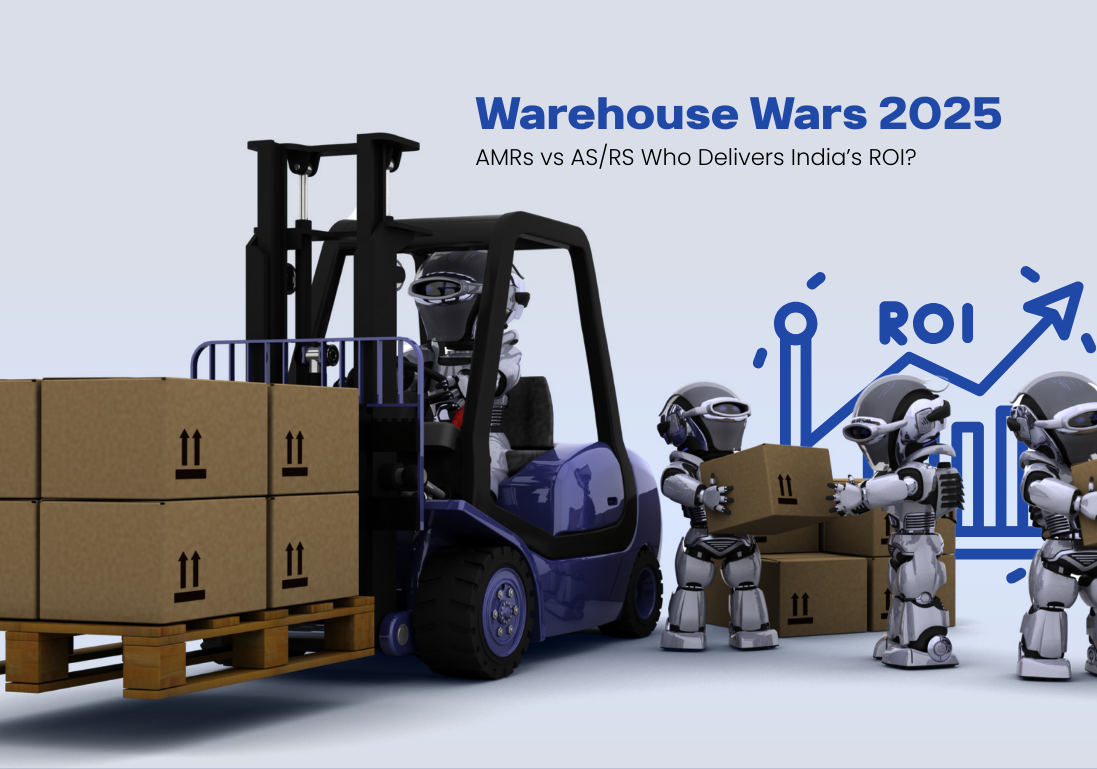Walk into any warehouse automation in India today, and you’ll feel the tension. Pallets are stacked high, orders are flying in, labor is stretched thin, and someone, somewhere, is asking the one question that now defines supply chains: “Should we automate, and if yes, which way?”
By 2025, the automation debate has narrowed to two heavyweights: AMRs (Autonomous Mobile Robots) and AS/RS (Automated Storage & Retrieval Systems). Both promise efficiency. Both reduce human error. But when CFOs ask about ROI in warehouse automation India, the answers aren’t so simple.
AMRs: The Hustlers on Wheels
Let’s start with AMRs. If you’ve ever been inside a new-age e-commerce DC outside Bhiwandi, you’ve probably seen them zipping around like busy delivery boys only quieter.
The magic of AMRs is flexibility. You can start small, add more robots when the Diwali rush hits, and scale back later if volumes dip. No civil work, no massive floor redesign. Just plug them into your WMS and get moving.
I’ve seen setups where AMRs paid back in under two years mainly because they cut down on overtime labor and missed delivery windows. But they aren’t perfect. Once your fleet gets into the hundreds, traffic jams start looking less like a warehouse and more like Silk Board Junction in Bengaluru.
So yes, AMRs are fast, flexible, and relatively cheap. But they shine best in places where demand is volatile and you can’t afford to sink ten crores into steel and cranes.
AS/RS: The Skyscrapers of Storage
Now contrast that with AS/RS. Think of it as building a high-rise inside your warehouse: tall racks, robotic cranes, shuttles that move with machine precision.
I visited a pharma facility in Baddi last year where an AS/RS ran through the night while the staff slept. No pick lists, no scrambling. Pallets in, pallets out. The ROI wasn’t immediate, but over five years, the math turned compelling.
This is the key: AS/RS is about density and discipline. In metro locations where land is gold Mumbai, NCR, Bengaluru these systems squeeze 30–40% more storage into the same footprint. They also deliver crazy throughput for FMCG and electronics, where demand is predictable.
But let’s be honest: the entry ticket is steep. A serious AS/RS project can cost three or four times more than AMRs, and once you build it, you’re married to the design. If your SKU mix shifts, it’s like trying to rewire a skyscraper; it doesn’t happen overnight.
The Warehouse Automation India 2025 Angle
Here’s where India makes the choice harder.
Labor is no longer cheap in every pocket. Attrition in hubs like Hosur and Bhiwandi is a headache, and wages are rising 8–10% annually. Land is even scarcer. Finding a 20-acre plot near Delhi or Mumbai is a nightmare, and rents are climbing.
Then add India’s demand volatility: Big Billion Days, Prime Day, flash sales, festive surges. Warehouses need to flex up and down in weeks, not years. That’s why AMRs feel like the safer bet for most players, fast to deploy (three to six months) and easy to scale.
Yet, when you zoom out five to seven years, the discipline of AS/RS pays off especially for companies with steady SKU portfolios and predictable flows.
So Who Wins the ROI Battle?
Honestly, there isn’t a universal winner. It’s contextual.
- A 3PL juggling multiple clients, each with different demand curves? AMRs win because flexibility trumps perfection.
- A consumer electronics brand with unpredictable demand? Still AMRs because you can add or subtract capacity as needed.
- A large FMCG or pharma giant with predictable flows and sky-high metro land costs? AS/RS is worth the pain the ROI comes later, but it comes big.
The most interesting models I’ve seen lately are hybrids: AS/RS managing dense storage in the back, AMRs handling floor movement in the front. Agility plus density. The best of both worlds.
The Verdict: Don’t Automate for the Trophy
The truth is, “winning” warehouse automation isn’t about showing off robots or cranes on LinkedIn. It’s about what shows up in your P&L.
If you’re growing fast but don’t know where demand will settle, start with AMRs. If your network is stable and land is your biggest constraint, AS/RS deserves a seat at the table. And if you’re smart, you’ll pilot both before betting big.
At the end of the day, the customer doesn’t care if a robot or a crane moved the box. They care that it showed up when you promised. That’s the only ROI that matters.
FAQs
1. What’s the biggest difference between AMRs and AS/RS?
AMRs are mobile robots fast to deploy, flexible, and relatively low cost. AS/RS are fixed systems expensive upfront, but unmatched in density and throughput.
2. Which delivers faster ROI in India?
AMRs usually pay back in 18–24 months. AS/RS takes longer (5–7 years) but can deliver bigger efficiency gains if volumes are steady.
3. Can the two work together?
Yes. Many warehouses are moving to hybrid models where AS/RS handles dense storage while AMRs manage last-mile movement inside the facility.
4. How long does deployment take?
AMRs can be up and running in 3–6 months. AS/RS usually takes 12–18 months because of construction, engineering, and integration.
5. Which industries benefit most from each?
- AMRs: E-commerce, 3PLs, electronics, and retail with volatile demand.
- AS/RS: FMCG, pharma, and auto spare parts with predictable, high-volume flows.

